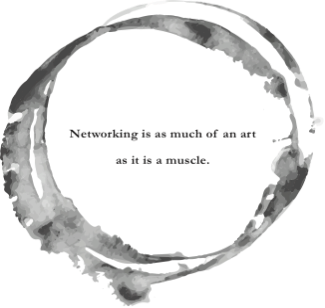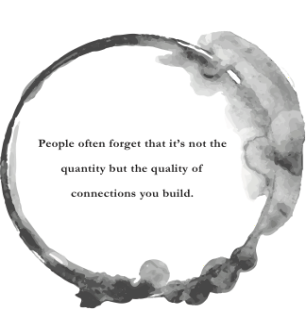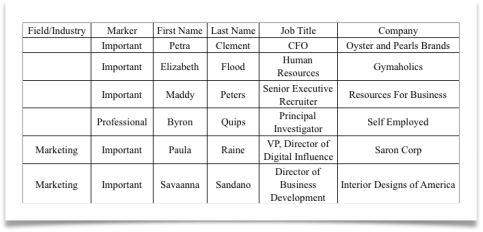

 |
 |


Trust. It’s usually disguised as the “benefit of the doubt” when you first connect with someone. More often than not, your word is taken at face value by strangers who believe whatever comes out of your mouth, as long as it makes sense to them. There’s a huge responsibility with this benefit and it’s easily lost when handled without care.
Being honest with your personal brand is vital to building influential relationships. It isn’t hard to run an internet search and discover that the social media strategist you met is actually a college student with a decent website and no experience. Just keep it real. Networking is as much of an art as it is a muscle. Not many people wake up and say, “Yes! I sure can’t wait to walk up to a complete stranger in a crowded party where I don’t know anyone and actively get to know them in an unobtrusive or non-awkward way.” Networking is still exhausting work even once you get the hang of it, however there are ways to keep it fun.
Because you have a solid personal brand, you’re actually more prepared than you think. The anxiety to meet new people or to engage with acquaintances comes from the fear of rejection and worry that what you have to say won’t be seen as valuable or useful to the person you’re hoping will receive you favorably.

The Anxiety
I’m no stranger to that odd-ball “outsider” feeling at events. It’s that exact feeling that everyone dreads hence why the term “networking” raises hairs. I certainly never liked going to events where I didn’t know anyone. It’s awful to see pockets of folks all over an event chatting it up together with you floating by each one hoping for a greeting or non-verbal cue to join the conversation such as a wave or smile that seems to never come. It’s equally awful when you find yourself standing around with no one to talk to for 10 minutes. Those 10 minutes usually feel like an eternity and you either get so turned off that you leave or get stuck with someone you don’t particularly care for. Sometimes you’re left standing in a corner eating one too many crab cakes while everyone else is busy collecting business cards.
Over the years, I’ve developed mechanisms to combat the awkwardness and anxieties about navigating crowds. Making sure I have a wing-man in the room, standing in strategic locations, doing my homework on the guest list, and having a few good stories ready to share are some of the ways to make “networking” events beneficial and less intimidating. After all, you’re simply trying to create meaningful connections with people and like any relationship building process, you may kiss a few frogs before finding that gem of a contact.

The Strategy
People gravitate to others who are interesting, dynamic, and have an air of confidence. Stories are a phenomenal way to share to your interests and personality in a conversation and is exactly what I do to break the ice. I talk wine any chance I get. I also talk travel and usually have a funny story from my latest international wine adventures to get a good conversation going.
At a client event several moons ago, I found a good spot close to the bar and set up camp, because face it, everyone goes to the bar at least once during the course of an event and you’re bound to meet someone that’s worth remembering as much as you are. This event in particular was a project finance conference after-party and an event covered in middle-aged white men with a lot of political reach and cool stories of their own.
I got to the event a little late so my prime “to-the-right” of the bar spot was already taken. All I could do at that point was introduce myself to the lucky bloke in my spot and asked how he was enjoying the event so far and what takeaways left a mark on him. I, of course, had a glass of wine in my hand and quickly got to asking the stranger about his latest travels. I used that time to learn about him and later transitioned the conversation into my travels, especially as they pertained to wine.
The man’s face quickly lit up and before I knew it, I was describing my favorite food and wine combinations. He shared some of his favorites, too. A few weeks later that same stranger sent me a note that read, “pleasantly surprised by the wine you suggested—never would have thought I’d be a fan. Cheers, Tiff!” That person is a great colleague of mine to this day.
Might I add, that was one of three business cards I collected that evening out of the 200+ people in attendance that night. I mention this because people often forget that it’s not the quantity but the quality of connections you build. I may have met 50 people but I’m never in a rush to collect cards or stay in contact unless I see real value from the interaction. Your time is as precious as theirs. Why exchange false promises of staying in touch when you’ve already got the vibe that it will fizzle anyway?
Selectivity is a great tool because you remove the pressure on yourself to get your card to as many hands as possible. You also get to the freedom to focus on one person at a time leaving room for a more genuine exchange of ideas. Good energy is magnetic and the right people tend to pick up on it.

Likeability is a Process
Before you can swim you must overcome your fear of being underwater. And before you can become a networking maven you have to overcome the anxiety of possible rejection. Your ability to foster a sense of comfortability and genuine admiration from those that cross your path is a process. Likeability can come naturally when you’re being introduced to someone who likes the same music as you. But to dig a little deeper and uncover similarities with someone new, in under fifteen minutes takes finesse.
You have to get to a place where you are able to “meet them where they are.” I created this mantra moons ago when trying to make my junior attorneys understand the fragility of connection building. How they needed to put themselves in other people’s shoes to find the right voice and motivations that would resonate with their targets. So let’s talk about some aspects of connection building.

I’m Pleased to Meet You
There are several important factors when preparing to meet someone in a casual business setting. Here is a review of the basics:
▪ Make good eye contact.
▪ Have a sturdy hand shake.
▪ Look relaxed.
▪ Hang in a central location.
▪ Have a 90-second pitch but don’t be robotic with it.
▪ Listen more than you speak.
What has worked for me, after the usual introductions, is having one question ready that usually forces a pause and prevents people from giving one-word answers or exiting the conversation quickly. That questions is: what was the most extraordinary thing you did today?
If you have ever been asked this question, I’m certain it made you stop and think. I’m also sure you remember the person that asked you the question. You may even have taken a while to answer it. Either way, it gave you an excuse to talk about yourself. Likeability is a delicate dance of being interesting, memorable, and engaging at the same time. It’s not distance or time that makes people closer, it’s the level of affection shared. Questions like this make people remember you because it’s unusual and expresses care. Strive for authenticity and you’ll make quality connections.
Keep in mind that your personal brand is meant to work for you. Do you remember those stories and experiences that set you on a course toward your credentials and nurtured your gifts? Well those stories are exactly what you talk about. Because you’ve written them down into organized thoughts, you can pick from the shelf depending on the conversation with meaningful things to say. I often tell my clients, have a 90 second commercial but don’t use it. Why? Because what ends up happening once you memorize your commercial, it sounds just like that—a robotic commercial. Instead, focus staying casual and molding your responses to the occasion or vibe of the conversation.
So what happens after you’ve successfully connected with someone either in person at an event or through some social network? Following up will be where the rubber meets the road. Right after an event, as I tell my attorneys, jot down quick facts about the person on the back of the business card they receive:
▪ Were they dressed well?
▪ Did they say something cool?
▪ Did you go to the same school?
▪ Did she tell you about a job you should apply to?
▪ Did he mention that he’d be happy to introduce you to someone else?
All of these nuggets should become notes that you can easily reference when moving their contact info into your phonebook or email lists. Did you know that it usually takes an attorney about six months to a year of steady and relevant interactions to build enough rapport with a new contact before they get a piece of business? There are exceptions to that rule but more often than not, like them, you too are in it for the long haul. This timeline doesn’t just apply to making a sale, but also for people interested in making connections that provide the gift of access to their spheres of influence. You have to build rapport and relevance with people long before you call on favors such as introductions to the hiring manager at a company you want to work at or for a family discount on a product you like that they’re selling.
Regardless of the motivation, what’s the best way to consistently manage such lengthy interactions? Good question. You should keep a list of important people that you meet every year and track your engagement. Now who’s important to you is a subjective area—that depends on what you’re after. Your goals, as always, should be clearly defined, so where does your list of people align with them? Are there things you need now that certain people you know have access to? These are the types of people that belong on your list. Because you have a mission to accomplish, it will be easier to prioritize your time based on the added value that your connections create. When coaching my attorneys on this I quickly realized that I needed to create a simple tool that would help them stay on task without the bells and whistles of complicated programs.

The Relationship Management Grid
I designed the Relationship Management Grid; better known by my clients as the RMG. It’s a simple spreadsheet that you can create on your own. Now, before you can begin any tracking process, you have to compile your spheres of influence into one place. It could be a simple document with all 400 names from your cellphone contacts, email address book, and professional social media accounts. For business owners, it could be potential client lists and service providers in your area. From that document, you then label each name with a marker highlighted in the grid below.


